By Buff Furman and Ron Swenson April 3, 2023

Fig. 1. Solar-powered automated transit would be above the ground-floor level. (Credit: Arturo Millan/RODZ+)
We are designing a solar powered, grade-separated, automated transportation network system we call the Spartan Superway. Several cities overseas are lining up to install such networks to meet their transportation needs (Figure 1). Is your city ready for the transportation solar revolution?
The transportation sector is charging ahead toward electrification, with more electric vehicles hitting the roadways and charging infrastructure being built out all over the country. This is a welcome development, given the fact that the transportation sector in the United States accounts for the largest share of greenhouse gas emissions (29%) and passenger automobiles account for 70% of that share.1
With renewable energy sources increasing in the electrical generation mix, won’t we all be able to just ride off into the sunset in our EVs to a happy fossil fuel-free electrical-transportation future? It’s not that simple. According to Antonio Guterres, United Nations secretary-general, “I have a special message for fossil fuel producers and their enablers scrambling to expand production and raking in monster profits: If you cannot set a credible course for net-zero, with 2025 and 2030 targets covering all your operations, you should not be in business.”
Vehicle electrification helps in the reduction of GHGs only to the degree to which the electrical-grid energy mix comes from renewable sources. In some parts of the United States, it would be worse to drive an EV than a vehicle with an internal combustion engine.2,3
In an equitable world, people would share mobility infrastructure and the private car would be reserved for special purposes. According to the architect Christopher Alexander, “Cars give people wonderful freedom and increase their opportunities. But they also destroy the environment to an extent so drastic that they kill all social life.”4
Safe by Design
An inherent design flaw in our transportation system is that unprotected humans (pedestrians, bicyclists, joggers, dog walkers, etc.) must compete with multi-ton vehicles for the same space on our streets.
The outcome of this collocation is horrific, with over 40,000 people killed and 1.5 million people injured every year on U.S. roadways (Figure 2).5 Let those numbers sink in for a moment.
The prevailing rationalization for these tragedies is that “human error and lack of responsible driving behavior account for the most fatalities on the road,” the editor Shelby Simon wrote in Forbes.6 However, this is a system-design failure, the responsibility of engineers, not drivers.

If human life is indeed valuable, then we demand that engineers and developers come up with intrinsically safe ways to transport people!
Spartan Superway to the Rescue
Motivated by the serious shortfalls outlined above, our solar-powered, grade-separated ATN system leverages solar energy and is inherently safe.
Figures 3a and 3b depict the general concept for SSW.7 The system consists of a network of elevated guideways below which a fleet of autonomous vehicles are suspended and above which a canopy of solar panels along the guideway collect the energy needed to power the system.
Figure 3b shows the guideway without the solar canopy so that the guideway tracks can be more clearly seen. Unlike corridor-based transportation modes such as a train or light rail that stop at intermediate stations, SSW uses a network of guideways with stations located on offline track sections so that passengers can travel nonstop from origin to destination, much like a taxi.
The idea for a network of guideways restricted to specialized automated vehicles and offline stations is not new,8 but the incorporation of solar PV above an elevated guideway was introduced to the American Solar Energy Society in 2007.9 After many years of R&D, projects are under negotiation with cities in several countries.


With grid-tied and locally-provided energy storage, SSW can operate 24/7 and provide a way to directly tie renewable solar energy to urban transportation. With its elevated guideways networked throughout a city, SSW physically separates lethal machinery from vulnerable living creatures and solves the safety issues that we currently suffer at street level.
Figure 4 shows a SSW vehicle at a station berth. The vehicles are envisioned to carry four to eight people in two separated, ADA-compliant compartments that can comfortably accommodate pets and luggage as well as personal mobility devices.
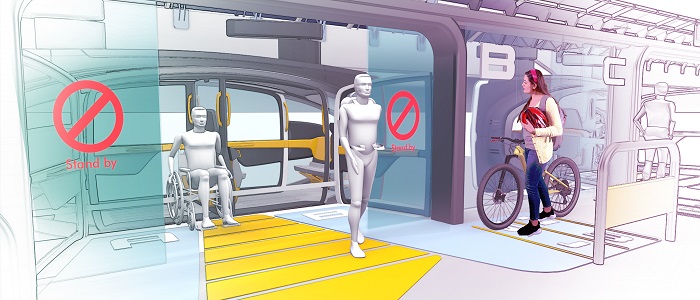
In some developing countries, policy makers are choosing to abandon auto-centric design and implement solar automated transportation. The potential is transformative. After decades of congestion and pollution, city leaders are embracing our lowest-cost, energy-independent system designed to serve entire communities, not just dense urban corridors.
During 2019-2021, our team of engineers, architects, product designers and urban planners in California, Illinois, Sweden and Mexico took on the challenge to answer two questions to establish that SSW is feasible and desirable:
- Can solar deliver the energy that a solar transportation system like SSW needs?
- How can available immersive, dynamic computer-modeling approaches be leveraged to help stakeholders who are saturated in current paradigms understand and buy into radically new approaches?
A research project sponsored by the Mineta Transportation Institute resulted in promising findings.10
The team used a test case for exploring the application of an SSW network connecting the north and south campuses of San José State University and containing three stations. Ridership data was available for a diesel shuttle bus fleet (Park & Ride) operated by the university, so its performance could be compared to a solar-powered alternative.
The network also presented realistic siting challenges for the guideway. One was how to traverse a major state highway that cut across a hoped-for direct route between the campuses. Figure 5 shows the final routing of the guideway and location of the stations.
The multi-modal transit-simulation package Simulation of Urban MObility with the Python extension SUMOPy and the university shuttle data were used to quantify the energy demand for reasonably realistic passenger demand over 24 hours.

Custom-written software was used to size the solar photovoltaic panels and battery storage the system needed to achieve net-zero performance. The PV canopies are eight modules wide for dual-direction guideways and six modules wide for single-direction guideways. Combined with PV canopies at the stations, the system will operate 24/7 with net supply to the grid.
The resulting energy system had a PV rated output of 6.2 MW, a battery capacity of 9.8 MWh, and an estimated cost of $11.4 million. Figure 6 summarizes the results of the energy analysis. The left vertical axis plots the annual energy sourced from or sent to the grid. The right vertical axis plots the energy-system cost (PV plus storage) and the horizontal axis plots the capacity of the energy-storage system.
The energy cost per passenger-mile was found to be $0.15 compared to $0.21 for the current shuttle operation. In addition to expanded 24/7 service and lower energy cost to operate, the solar ATN had vastly better greenhouse gas (0.03 lb CO2/passenger mile vs. 1.46 lb CO2/passenger mile) and particulate emissions (2.3 mg PM2.5 compared to 109.3 mg PM2.5).
So we can see that from an energy and emissions standpoint, yes, grid-tied solar PV with local energy storage is feasible and up to the task of powering an urban transportation system.

For the second research question in the MTI project, the team used ArcGIS extensively to map, study and document the proposed guideway route. Route planning followed a few principles to minimize the impact of installing the guideway structure on existing rights of way. These included:
- Avoiding guideway placement that would take away car-traffic lanes.
- Avoiding conflict with street trees.
- Avoiding areas with dense electric cables and poles.
- Identifying a vacant space for potential station sites every 400-500 meters along the route.
- Preventing overlap between guideways.
All three stations were located in areas of high use and thoughtfully designed to make use of air space to minimize the impact on vehicle traffic and parking (Figures 7, 8 and 9).
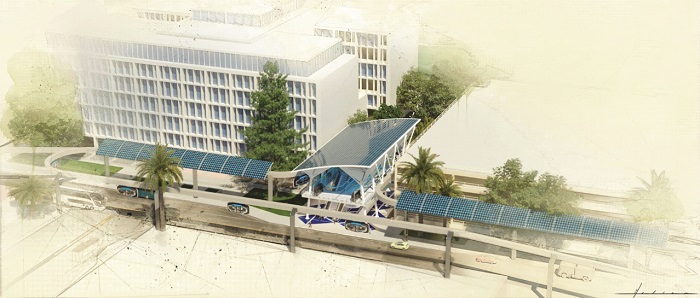
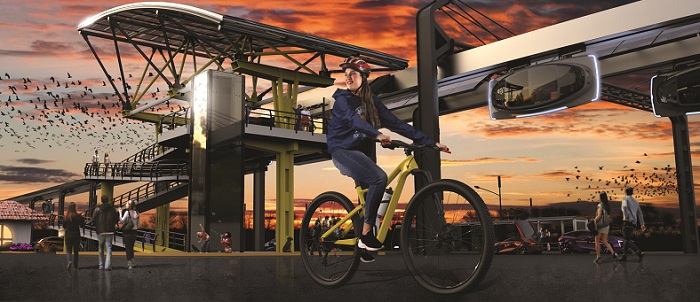
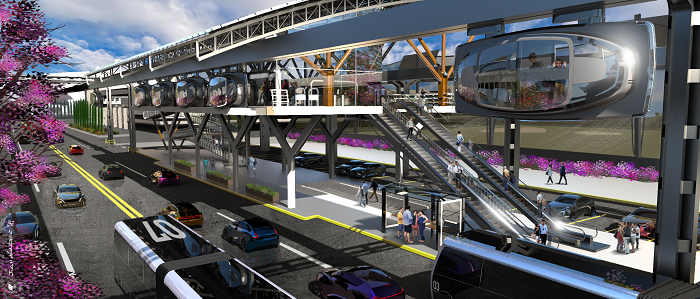
Figure 10 shows the basic concept that would allow the guideway to cross Highway 280, a major freeway that divides the city of San Jose. We used Google Maps and onsite investigation to identify five overpasses beneath which the guideway could be located. We found that it made the most sense to route two one-way guideways underneath the 3rd and 4th St. overpasses (see Figures 5 and 10).

As shown above, SSW can be retrofitted into urban areas by placing vertical supports every 12-24 meters (39’-79’) along and rising above existing roadways. The relatively small at-grade footprint of the guideway structure would minimize disruption during construction. Guideways can also strike out over open land to connect remote communities into the regional transportation infrastructure.
Moving on to Meet Global Needs for Sustainable, Safe Transportation
We would like to see cities in the United States warm up to our transformational approach and join forces with cities in several countries that are establishing SSW networks to achieve climate equity and desperately needed economical, reliable mobility for all.
SSW is affordable even for impoverished settlements where streets are improvised, energy outages are persistent, and marginal areas may even experience frequent flooding (Figure 11).
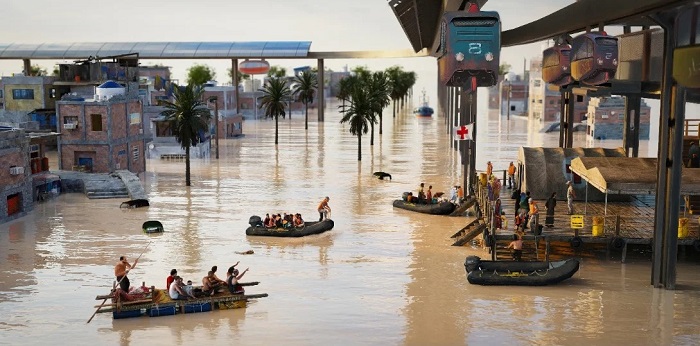
Our system with a post in the ground every 50-100 feet is straightforward in comparison to ordinary roads, light rail, monorails, subways and even bus rapid transit that displace people and create barriers to social interaction – and are hopelessly expensive.
SSW rises above those challenges. The cost of land acquisition is negligible and construction disruption is minimal. Unsubsidized pricing becomes feasible through intensely focused cost-informed design and public-private-partnership funding (Figure 12).
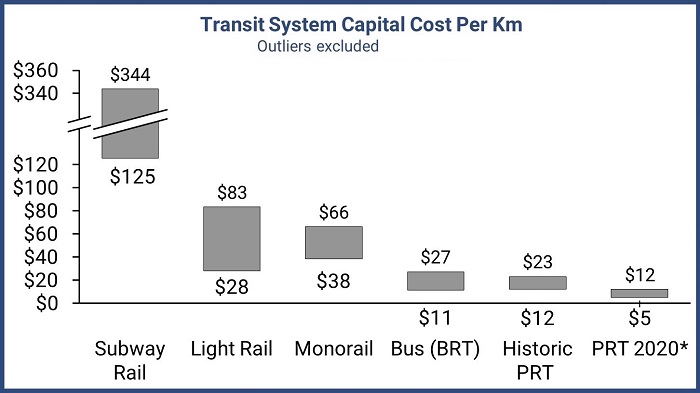
A Call to Action
It has been said that there are three kinds of people in the world: those who make it happen, those who watch it happen and those who wonder what happened. The bold approach of SSW can achieve a decarbonized-transportation future that promotes human flourishing.
If we have sparked your imagination, read our full report, watch the videos and share them. They are available online at https://tinyurl.com/bd5ueh9w. You can also visit SolarSkyways.com to see our work on the commercialization of SSW.
We challenge you to come up with an even better 100%-solar solution or join us to make SSW happen!
Sources
- https://tinyurl.com/yc36ye39
- https://tinyurl.com/bdf7m535
- https://tinyurl.com/96j2jx2z
- https://tinyurl.com/8mm9tpjd
- https://tinyurl.com/4a9vcvp2
- https://tinyurl.com/2nufy5v9
- https://tinyurl.com/bd5ueh9w
- https://tinyurl.com/ybkpmtxy
- https://tinyurl.com/4kt248a6
- https://tinyurl.com/bd5ueh9w
- https://tinyurl.com/53vcfw8x
- https://tinyurl.com/4hbpcp2p
About the Authors
Buff Furman is a professor of mechanical engineering at San José State University and a research associate at the Mineta Transportation Institute. He led studies on automated transportation networks in 2014 and 2021. He has been working intensely with interdisciplinary groups of students and industry sponsors to develop solar automated transportation networks.
Ron Swenson built a solar tricycle in 1981 and led the Solar Transportation Division of the American Solar Energy Society while mentoring the first Mexican solar-race-car team in the 1996 World Solar Challenge. Inspired by solar-car racing, he co-founded Spartan Superway in 2012 to support flourishing, human-centered cities based on solar energy.




